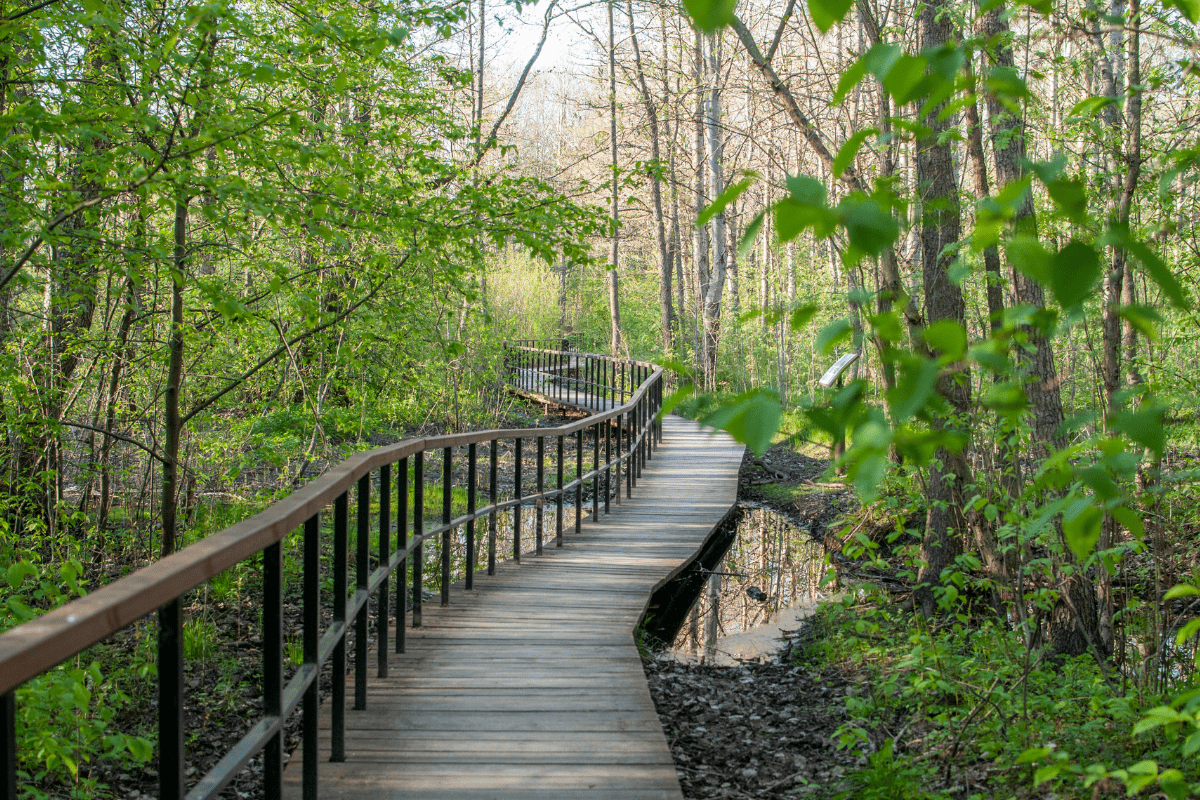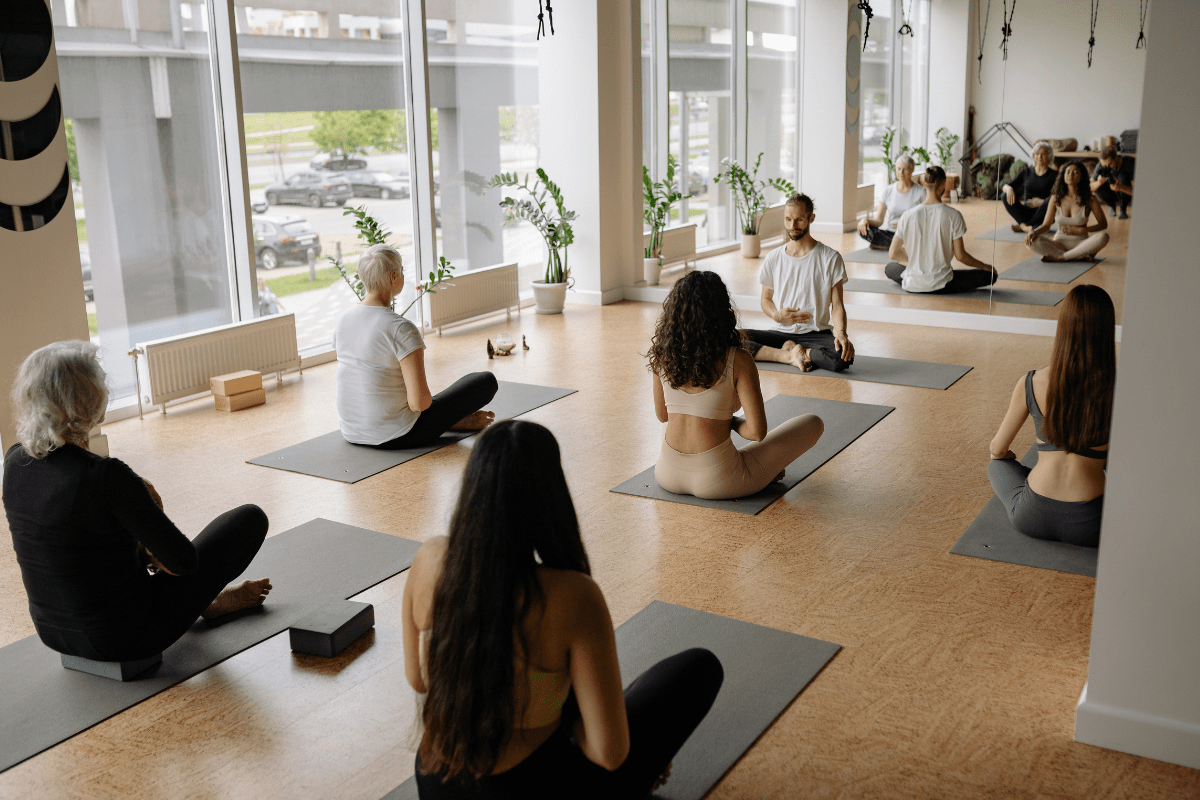Finding lush boardwalks, hidden lakes, and wild Florida scenery is easier than you might think… just step beyond the city streets and Naples reveals an incredible lineup of hiking trails. Whether you prefer stroller-friendly walks or remote swamp treks, there’s a path here for every pace and interest.
Let’s get to it.
Baker Park
At Baker Park you can enjoy a 1.3-mile loop trail that follows the Gordon River at a relaxed pace. The entire route is paved and includes wide boardwalk sections where strollers and leashed dogs pass comfortably. The path climbs only about 16 feet in elevation, so it feels nearly flat while still offering a sense of achievement.
Along the way you’ll find a splash pad, two playgrounds, and pockets of native gardens. A grassy knoll provides a nice spot to rest and look over the river corridor. Free parking is plentiful and restrooms are clean and functional. Benches appear at regular intervals, so it’s easy to pause and take in the scenery. If you want a longer outing, the kayak launch and pedestrian bridge connect directly to the Gordon River Greenway. Early mornings are ideal to avoid crowds and Florida’s heat later in the day.
Gordon River Greenway Park
Gordon River Greenway Park offers about two and a half miles of mostly flat trails and boardwalks. The network runs along the river, with views across mangrove-lined banks and several bridges that connect different segments. Total elevation gain is under ten feet.
Along the trail you’ll find fishing piers, a treehouse-style playground, and benches for breaks. Lamp-lit routes, water fountains, and picnic shelters make this park user-friendly from dawn until dusk. Paths are wide enough for strollers, wheelchairs, and cyclists to share comfortably. Leashed dogs are permitted and pet waste stations are provided. Interpretive signs and emergency call posts are spread throughout the route. Crowds tend to build after 9 a.m., so plan for early or late visits if you prefer more space. A kayak launch at one end adds a water-based option to your outing.
Freedom Park
Tucked away in a natural preserve, Freedom Park spans 50 acres centered around a five-acre lake. A mostly paved loop trail of just over one mile circles the water, while a 0.6-mile boardwalk floats through adjacent wetlands and forest hammocks. Gentle grades make the route accessible to most visitors.
Along the trail you may spot wading birds, alligators basking near the water’s edge, or even the occasional river otter. Six shaded pavilions and plenty of benches provide comfortable rest stops. The park meets ADA standards for trails, parking, restrooms, and drinking fountains. Leashed dogs are welcome on the pathways. Maintenance is consistent and the grounds stay clean. Morning and evening visits help avoid summer heat and occasional traffic noise from the nearby parkway.
Delnor-Wiggins Pass State Park
Delnor-Wiggins Pass State Park makes Gulf coast beauty easy to access. A raised boardwalk winds through mangrove swamps and cabbage palm hammocks on a main trail of about 0.6 miles. A side loop to the observation tower adds roughly 0.3 miles more, with only minimal elevation change throughout.
The beach beyond the trailhead offers soft sand and scattered shells, ideal for shelling and birdwatching. A covered picnic pavilion sits just off the trail, and park staff provide both standard and electric beach wheelchairs. Dogs are welcome only in picnic areas, so the main trails remain wildlife-friendly. Restrooms and parking are well maintained and there’s a boat ramp for small craft. The park is open daily from 8 a.m. until sunset, year-round. Weekday mornings tend to be the quietest times.
Naples Botanical Garden
Stepping into Naples Botanical Garden feels like entering a carefully curated oasis. Spread over 170 acres, the grounds feature several themed areas—from a lush tropical water garden to a grove of soaring banyan trees. Flat walking paths total just over 2.5 miles and include smooth boardwalks through wetland habitats.
The entire route is stroller- and wheelchair-friendly with ramps and clearly marked rest areas. Wayfinding signs and maps help you stay on course, while shaded benches and water fountains offer regular relief from the sun. A café on site serves light fare, and there’s a gift shop for souvenirs. Parking is available on site and restrooms are well maintained. Only service animals are permitted inside. Morning visits are best during summer heat and winter crowds tend to peak in the midday hours.
CREW Bird Rookery Swamp Trails
CREW Bird Rookery Swamp Trails showcases Florida’s wild side without charging admission. The first section is a 1,500-foot boardwalk over a clear swamp, featuring wheelchair access and close views of cypress and maple trees. Beyond the boardwalk, a network of sandy and grassy former tram roads stretches nearly 12 miles, with a shorter 4.5-mile loop available for a quicker outing.
The mostly flat pathways may become soft after rain, and benches appear at regular intervals for rest stops. Wildlife sightings often include various wading birds, deer, otters, and, on rare occasions, panthers. Dogs are not permitted, preserving the quiet atmosphere for birdwatchers. Facilities at the trailhead include parking, an information kiosk, and a porta-potty. The best months to visit are November through May, when cooler weather and fewer mosquitoes improve trail conditions.
Clam Pass Park
At Clam Pass Park, a raised wooden boardwalk guides visitors through a 35-acre mangrove forest and wet prairie. The level trail spans about 0.75 miles one way, and a free tram runs continuously for those who prefer not to walk. Along the way, you’ll spot white ibis, herons, and a variety of butterflies. At the end of the boardwalk, the Gulf of Mexico appears just beyond the dunes.
Parking includes 182 spaces and costs ten dollars unless you have a county permit. The site features restrooms, outdoor showers, beach wheelchairs, and rentals for chairs, umbrellas, and paddleboards. Dogs are not allowed, which helps keep the beach area quiet. The park’s award-winning beach restaurant offers a convenient way to end your visit with a meal or drink. Peak conditions occur from December through May, when cooler temperatures and migratory bird species make the park especially enjoyable.
The Naples Preserve
The Naples Preserve provides a quick look at native Florida habitats. A 0.4-mile raised boardwalk winds through oak-rosemary scrub and pine flatwoods. The flat, sturdy surface accommodates strollers and wheelchairs without difficulty.
Along the path, interpretive signs explain local plants and animals. A nearby pollinator garden attracts butterflies, while benches offer quiet spots for observation. Wildlife sightings might include gopher tortoises and a variety of songbirds. Only service animals are allowed, which maintains a calm environment.
Parking is available adjacent to the Eco-Center building, and restrooms are located inside. The facility is well maintained by the City of Naples, and visit lengths usually range from 20 to 30 minutes. Peak visitation aligns with bird-watching season, but crowds remain light. The preserve’s compact layout and clear trail markings make it an efficient stop for anyone seeking a brief, educational nature experience.
Marsh Trail – Ten Thousand Islands NWR
Marsh Trail at Ten Thousand Islands National Wildlife Refuge offers a simple out-and-back stroll ideal for spotting coastal wildlife. The 2.2-mile route begins on pavement before transitioning to crushed shell and gravel. The surface can get uneven after rain, so sturdy footwear is recommended.
Along the way, egrets, herons, dolphins, and manatees may appear in the marsh channels. An observation tower halfway along provides elevated views, and its lower level is wheelchair accessible. Benches appear at regular intervals to break up the walk. There are no restrooms, water fountains, or food services, so bring supplies. Dogs are not allowed, preserving the habitat for birds and other wildlife.
Parking includes just 18 spaces, so midday visits can mean a short wait. The trail is open year-round, but winter months draw migratory birds and tend to be more comfortable. Even in wet weather, routine maintenance keeps the path usable and limits muddy sections.
Sugden Regional Park
Sugden Regional Park combines lakeside fun with gentle trails. On Lake Avalon, visitors find a freshwater beach, paddle boat rentals, and shaded picnic areas under mature trees. A paved 1.7-mile loop circles the park with minimal elevation change and a wide, smooth surface. Benches and shaded spots appear at frequent intervals, offering relief from afternoon sun.
From December through April, temperatures are mild and comfortable for strolls or family outings. Dogs on leashes are welcome, and a large playground plus a butterfly garden keep children entertained. Accessible parking sits near the trailhead, and the entire path is wheelchair friendly. Crowds tend to thin out quickly, so finding a quiet spot among picnic tables is rarely a problem. The park’s clean, flat layout makes it an ideal choice for a relaxed lakeside visit.
Big Cypress Bend Boardwalk
This quick Florida stop manages to be both laid-back and genuinely captivating. The trail is barely 0.2 miles, so there’s no “are we there yet?” moment. The entire route sits on an elevated wooden boardwalk, which keeps you above mud, snakes, and surprise puddles.
Ancient cypress trees rise all around, their knobby roots crawling across the swamp floor. Interpretive signs appear at intervals, identifying wading birds, plants, and other swamp residents. Alligators often bask nearby. Turtles show up occasionally, but usually they ignore passersby.
Benches provide perfect rest spots, and the wide, flat boardwalk accommodates strollers and wheelchairs. You’ll find fewer visitors on hot weekday afternoons, though winter draws a crowd of people escaping humidity and mosquitoes.
Convenient parking, restrooms, clear signage, and dog-friendly rules (on a leash) make planning easy. Lots of shade shields the sun. For a short nature outing that covers the essentials, this boardwalk delivers.
Collier-Seminole State Park
Outdoor enthusiasts at Collier-Seminole State Park will find a compact introduction to Florida’s wetland ecosystems. Options range from paddling and fishing to a stroll along the Royal Palm Hammock Boardwalk, a flat walkway through old tramway sections and wetlands teeming with life. Interpretive signs explain the roles of royal palms and gumbo limbo trees. Benches appear at intervals, and you might spot orchids, wading birds, or even a bobcat. Most of the boardwalk remains stroller friendly unless heavy rain invites mosquitoes.
For a more vigorous hike, the Strand Swamp and Flatwoods Trails wind through cypress swamps and pine flatwoods. Muddy footing is common outside winter, so carry bug spray and sturdy shoes. The Prairie Hammock Trail stays drier if you stick to the raised berm and may bring sightings of white-tailed deer or gopher tortoises.
Seasoned hikers can tackle the nearly seven-mile backcountry loop. This route demands solid footwear, readiness for deep standing water, and no shortcuts. Crowds are rare, so plan carefully and carry sufficient water and supplies.





